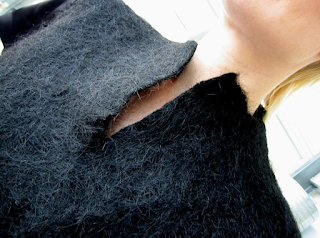 Ralph Gibson - "Ducktail" - 1975 - via Phoenix Art Museum
Ralph Gibson - "Ducktail" - 1975 - via Phoenix Art MuseumMay 13, 2011
May 5, 2011
Hidden hair
Pink silk satin printed in thorn pattern with encapsulated human hair
From the collection of Isabella Blow courtesy of the Hon. Daphne Guinness
Photograph by Sølve Sundsbø
From the collection of Isabella Blow courtesy of the Hon. Daphne Guinness
Photograph by Sølve Sundsbø
For his MA Fashion Design course at Central Saint Martins in London, Alexander McQueen hid human hairs into ensembles he designed for his 1992 graduation collection Jack the Ripper Stalks His Victims. For example, he sealed hair from view by sewing it into the lining of a frock coat (currently on view in the Metropolitan Museum's exhibition Alexander McQueen: Savage Beauty). McQueen's early collections related to the darker tendencies of Victorian era, such as death and the underbelly of society.
“The inspiration behind the hair came from Victorian times when prostitutes would sell theirs for kits of hair locks, which were bought by people to give to their lovers. I used it as my signature label with locks of hair in Perspex. In the early collections, it was my own hair.”
~Alexander McQueen
Time Out (London), September 24–October 1, 1997
The fashion historian Caroline Evans pointed out, in her book Fashion at the Edge, that by encasing locks of his own hair, "the themes of sex, death, and commerce intertwined...creating an object which was both souvenir and memento mori; he had the idea of giving himself to the collection."
 Another interpretation for McQueen's inclusion of hair in this collection was made by Louise Wilson, McQueen’s teacher at Central Saint Martins. Ms. Wilson remembers that because one of McQueen’s relatives owned an inn that housed a victim of Jack the Ripper, the collection "was linked to his mother; it was linked to her interest in genealogy." And what is more fitting than to use hair, actual DNA.
Another interpretation for McQueen's inclusion of hair in this collection was made by Louise Wilson, McQueen’s teacher at Central Saint Martins. Ms. Wilson remembers that because one of McQueen’s relatives owned an inn that housed a victim of Jack the Ripper, the collection "was linked to his mother; it was linked to her interest in genealogy." And what is more fitting than to use hair, actual DNA.
~
Elena Fajt, visual artist and assistant professor of fashion design at the University of Ljubljana, Slovenia, has also used hair in clothing. Her focus is the actual revulsion people feel about the context of hair. While considered beautiful and sexually attractive on the head, it becomes reviled once removed to another context. Her project Hairsense/Hair Dress explores the idea that hair is a renewable fiber that could one day be considered an acceptable material for fashion designers. Well if the Project Runway judges' reaction to Chris March's use of hair in his collection for the Season 4 finale in 2008 is any indication, we're not quite there yet. He lost....by a hair.
May 2, 2011
Melanie Bilenker
Melanie Bilenker's jewelry is a series of intimate acts. It is not simply the domestic imagery on her lockets, pendants, and rings - scenes of her sleeping, eating, getting dressed (and undressed) - but Melanie then re-creates these images out of single strands of her own hair. 'nuff said.
Erik Mark Sandberg

Subscribe to:
Comments (Atom)







